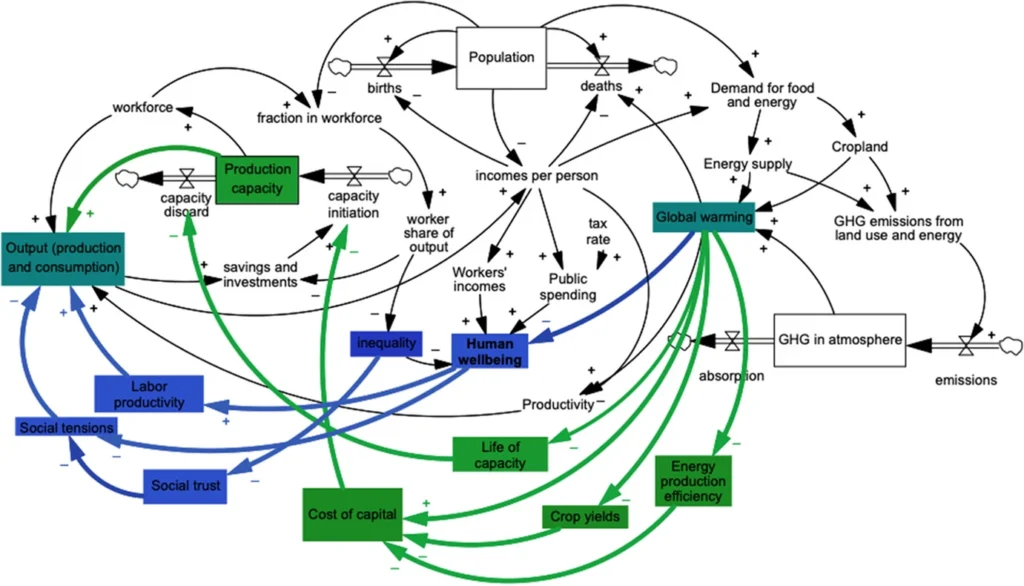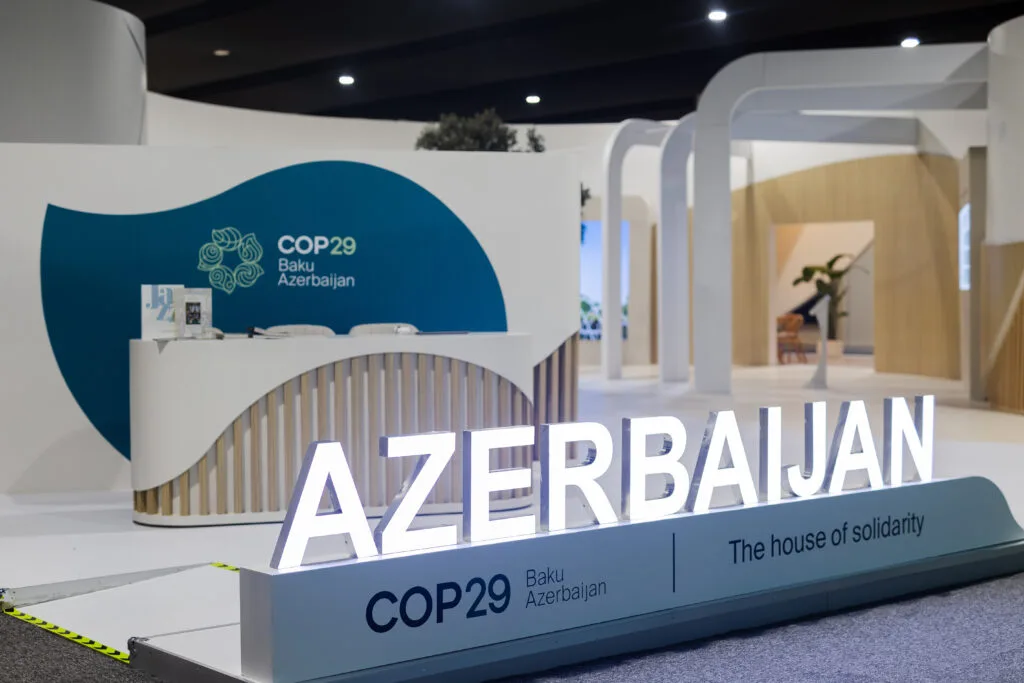Landmark global analysis by international team of scientists and economists warns of rising social tensions and sets out survival pathways for humanity.
Left unchecked, rising inequality in the next 50 years will lead to increasingly dysfunctional societies, making co-operation to deal with existential threats like climate change more difficult, according to ground breaking analysis being launched today in a new book, Earth for All: A Survival Guide for Humanity. However, the world can still stabilise global temperatures below 2°C and approach an end to poverty by 2050 by enacting five ‘extraordinary turnarounds’ that break with current trends.
“We are standing on a cliff edge,” said Jorgen Randers, one of the six authors of Earth for All and co-author of The Limits to Growth published 50 years ago. “In the next 50 years, the current economic system will drive up social tensions and drive down wellbeing. We can already see how inequality is destabilising people and the planet.”
“Unless there is truly extraordinary action to redistribute wealth, things will get significantly worse. We are already sowing the seeds for regional collapse. Societies are creating vicious cycles where rising social tensions, that are exacerbated by climate breakdown, will continue to lead to a decline in trust. This risks an explosive combination of extreme political destabilisation and economic stagnation at a time when we must do everything we can to avoid climate catastrophes.”
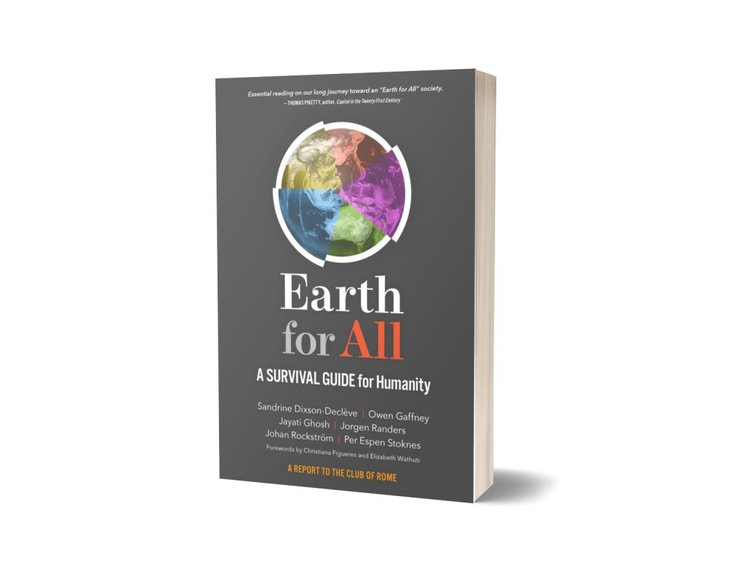
Ahead of significant political events such as UNGA and COP 27 Earth4All is launching Earth for All: A Survival Guide for Humanity, which presents the results of a two-year research project, that brought together leading scientists, economic thinkers and a team of ‘systems dynamics’ computer modelers.
The book builds on the common mantra from social movements calling for “Systems Change Not Climate Change” and “People Not Profit”. It lays out what economic systems change really means for civilization and proposes five extraordinary turnarounds that provide a framework for a fair, just, and affordable economic transformation. The book tackles the fierce debate between advocates for “green growth” and supporters of “degrowth” economies.
Sandrine Dixson-Declève, author and co-president of The Club of Rome said, “Our economic and financial systems are broken, and we are reaching dangerous levels of inequality. Do we want to create the first trillionaire or do we want to create functional, fair democratic societies? Ultimately, Earth for All is about building societies that value prosperity for all rather than profit for the few on a finite planet fit for the 21st century. Let’s be clear, a more equal society benefits everyone, even the very rich.”
The book explores two scenarios beginning in 1980 and ending in 2100. These scenarios entitled Too Little, Too Late and The Giant Leap explore how population, economies, resource use, pollution wellbeing and social tensions might change this century based on decisions made this decade.
Too Little, Too Late Scenario
In the first pathway, the world continues with the economic policies from the last forty years. While GDP continues to grow, the rich get richer while the poor fall farther behind, creating extreme inequalities and growing social tensions within and between countries. Political division and lack of trust make it increasingly difficult to address climate and ecological risks.

Global temperatures soar to about 2.5°C by 2100, significantly exceeding the target stipulated in the Paris Agreement. The poorest economies face the most extreme conditions. They struggle to adapt to climate impacts. Later in the century around two billion people will be living in areas that are close to the limits of human habitability1. All societies will be reeling from rolling shocks of extreme heat, drought, crop failure and floods.
If the world continues on the ‘Too Little, Too Late’ pathway, the model shows declining wellbeing globally, by an average of -40% in the 2050s than in the 2020s, even in wealthy nations, and suggests it will take until 2100 to eradicate extreme poverty as the poorest economies experience stagnating economic growth. According to the modelling, world population will peak just under nine billion people around 2050.
Per Espen Stoknes, co-author and director of the Centre for Sustainability at Norwegian Business School said, “In this scenario, the model indicates that regional societal collapse, driven by rising social tensions, food insecurity and environmental degradation, is more likely than today. Regional and global crises are often not caused by a single event like one crop failure, but cascading failures made worse by climate change, chronically dysfunctional governments and system failures.”
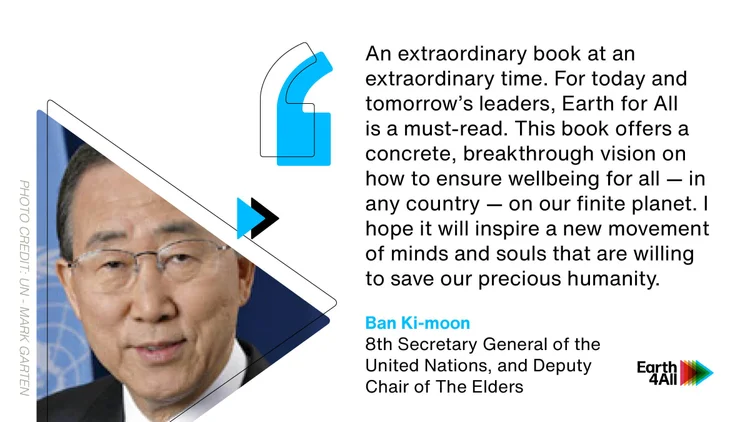
“We have known shocks were coming our way since 1972, and yet the response has been denial, it is now time to hold governments accountable for the future and push for strong governance models flexible enough to deal with today’s complex challenges.”
The Giant Leap scenario
The model offers a solution through a second, achievable path, ‘The Giant Leap’. The authors conclude that it is possible to stabilise temperatures below 2°C (above pre-industrial levels), stabilise the population well below nine billion people, reduce material use and approach an end to extreme poverty globally by 2050 – a generation earlier than the Too Little, Too Late scenario. In this scenario, social tension falls, and wellbeing rises throughout the century because of greater income equality.
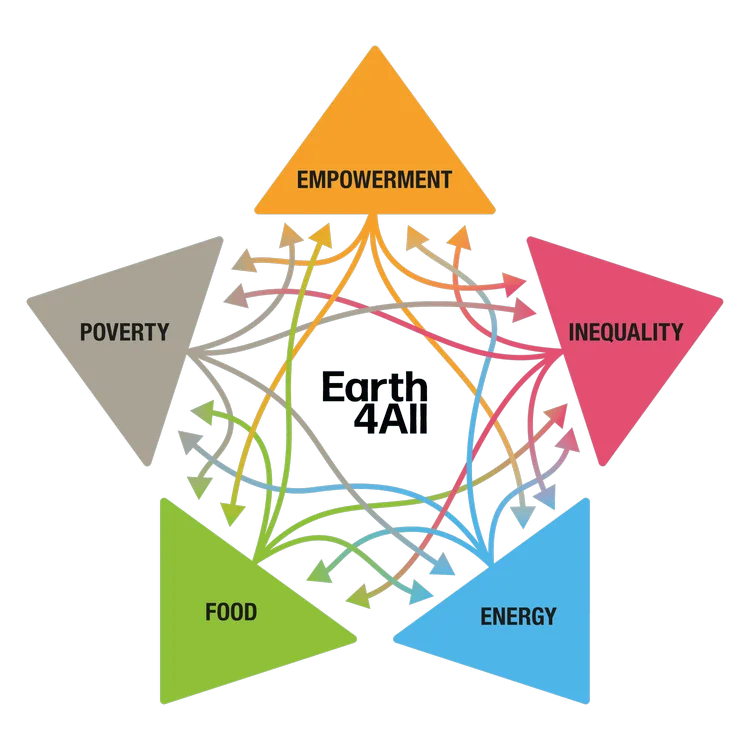
The model shows that to achieve The Giant Leap, societies would need to adopt unprecedented and immediate action across five interconnected turnarounds:
- Ending poverty through reform of the international financial system, lifting 3-4 billion people out of poverty
- Addressing gross inequality by ensuring that the wealthiest 10% take no more than 40% of national incomes
- Empowering women to achieve full gender equity by 2050
- Transforming the food system to provide healthy diets for people and planet
- Transitioning to clean energy to reach net zero emissions by 2050
Fifteen policy recommendations with the greatest potential to accelerate these turnarounds are outlined in the book.
Johan Rockström, director of the Potsdam Institute for Climate Impact Research commented, “Out of hundreds of potential solutions, we have found five interconnected turnarounds that represent the simplest and most effective solutions that we must start implementing this decade to build economies operating within planetary boundaries by around 2050.”
Sandrine Dixson-Declève continues: “Citizens across the globe recognise we need a new paradigm. And we estimate the investment needed for this shift is small, just 2-4% of GDP annually. That’s less than our current annual subsidies to fossil fuel industries. This is easily affordable, and it will create millions of jobs. What is missing is coalitions of politicians willing to make it happen.”
Owen Gaffney, author and global sustainability analyst at the Stockholm Resilience Centre continued, “The wealthiest 10% currently have 50% of global incomes. Effective progressive taxation, including wealth taxes, can easily provide the funds needed for The Giant Leap. These solutions will also help redistribute wealth which will go a long way towards reducing polarization and building the trust and legitimacy governments need to take giant leaps.”
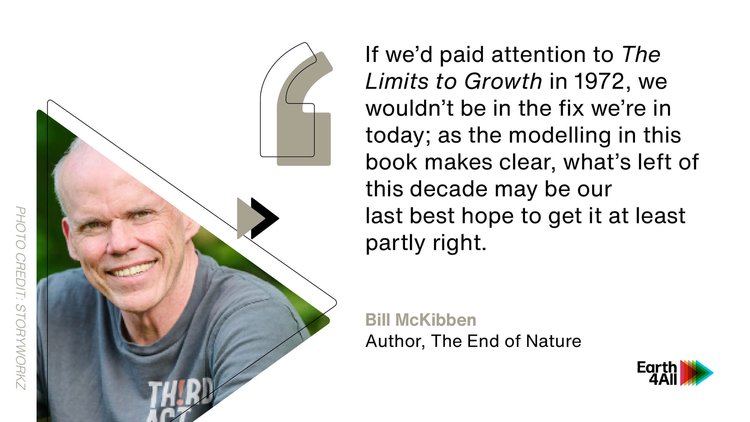
That is why the authors also argue for the creation of a novel financial innovation, the Citizen’s Fund, to tackle inequality, reduce greenhouse gas emissions, and provide a safety net for the most vulnerable through economic shocks. The fund would distribute the wealth of the global commons to all people as a Universal Basic Dividend.
The Earth4All survey on attitudes to transformation found that, among G20 countries, 74% of people supported economic systems change to go beyond a singular focus on profit and growth, and instead encompass health and the planet.
Sandrine Dixson-Declève continued, “The Giant Leap does not mean an end to economic growth, but it is the end of directionless economic growth that is destroying societies and the planet. New initiatives like the Wellbeing Economy Governments (WEGo) and the European Green Deal show that there is growing government support for moving beyond GDP and growth at all costs towards new wellbeing indicators and greater wealth distribution. ”
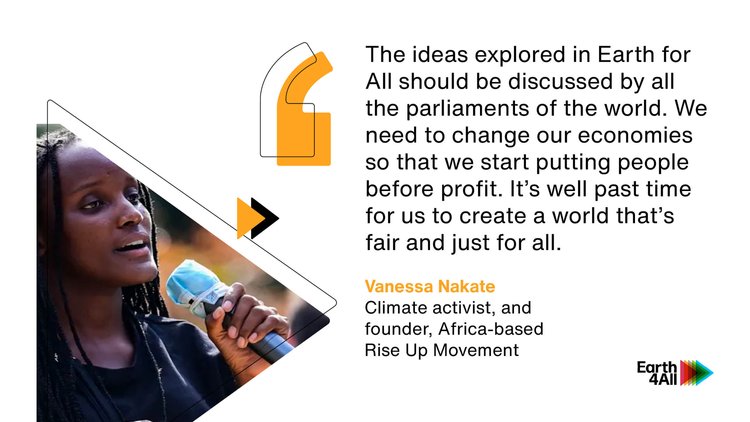
Jayati Ghosh, development economist and professor of economics at the University of Massachusetts Amherst, summarises the importance of this new publication, “Hell on Earth awaits many people already living in poverty. This is why Earth for All is not just a book – it is a call to action. Because the necessary changes are so big, they require determined social movements with broad participation. History shows that inertia and defeatism can become self-fulfilling. But it also shows that governments ultimately must respond to popular pressure or be replaced by it. ”
The book, Earth for All: A Survival Guide for Humanity, will be published in German on the 6 September 2022 and in English on 20 September 2022. The book will also be available in Japanese, Chinese, Korean and Italian.
The Earth4All movement
Earth4All is launching a public campaign, hosting a series of events and citizens assemblies throughout 2022 and 2023, to bring together everyday people to devise recommendations to governments on the best way forward to make societies more equal and less polarized.
About Earth4All
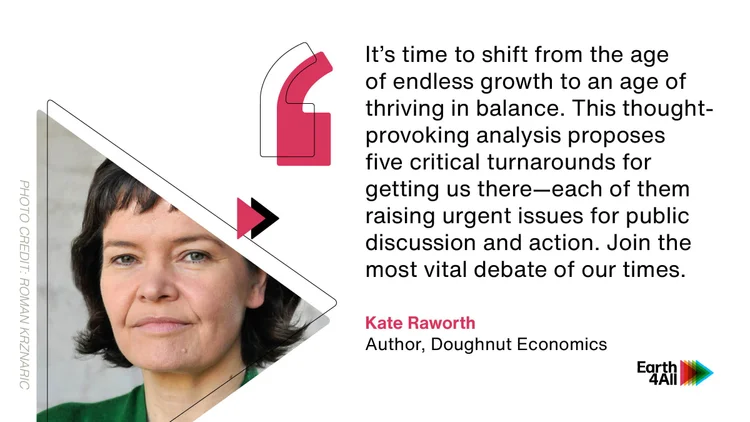
Earth4All is a vibrant collective of leading economic thinkers, scientists and advocates, convened by The Club of Rome, the Potsdam Institute for Climate Impact Research, the Stockholm Resilience Centre and the Norwegian Business School.
Earth4All builds on the legacies of The Limits to Growth and the Planetary Boundaries frameworks. Science is at the heart of our research work. We rethink capitalism and move beyond GDP for a safe, secure and prosperous future in the Anthropocene. www.earth4all.life
About Earth for All: A Survival Guide for Humanity
The book, for the first time, presents the results of a remarkable two-year research collaboration, Earth4All.
The Earth for All book will be published in September 2022 in English and German. It is available both to download as an e-book and in paperback. Chinese, Japanese, Korean and Italian versions will be available soon.
The book will be published in German on the 6th September and in English on the 20th September.
The book can be ordered in English and in German (here).
Terminology
In Earth for All the term “collapse” refers to when a society (or societies) enter a vicious cycle where rising social tensions lead to a decline in trust causing political destabilization. This in turn leads to stagnating economies and a fall in wellbeing. The government then struggles to regain trust, making it increasingly challenging to make coherent long-term decisions. It might take a society a decade or more to return to a more functional state.
Authors of Earth for All: A Survival Guide for Humanity
- Sandrine Dixson-Declève, Co-President, The Club of Rome and Chair, Economic and Social Impact of Research (ESIR); Chair, Advisory Board, UCL Bartlett School; Senior Associate, Cambridge Institute for Sustainability Leadership
- Owen Gaffney, global sustainability analyst and writer and head of media at the Stockholm Resilience Centre, Analyst and Policy Advisor at the Potsdam Centre for Climate Impact Research, Fellow, Future Earth and Edmund Hillary Foundation.
- Jayati Ghosh, Development Economist, Professor at University of Massachusetts Amherst.
- Jorgen Randers, Professor Emeritus of Climate Strategy, BI Norwegian Business School, Co-Author of The Limits to Growth.
- Johan Rockström, Professor in Earth Systems Science; Director of the Potsdam Institute for Climate Impact Research.
- Per Espen Stoknes, Author, Psychologist, Director of the Centre for Green Growth at the Norwegian Business School, previously Member of the Norwegian Parliament.
The book is the result of collaboration between the 21st Century Transformational Economics Commission and systems analysts and modelling teams. The full list of contributors can be found here.
Methodology of Earth4All
The Earth for All book presents the results of a two-year research collaboration including the outcomes from the Transformational Economics Commission, data from a novel Earth4All system dynamics computer model and assessment of recent research findings, including a Social Tension Index and a Wellbeing Index to track plausible socio-economic scenarios this century.
Two new Earth4 models: a global model with 800 interactions and a regional model with 10 regions (Sub-Saharan Africa, south Asia, south-east Asia, China, western Europe, eastern Europe and central Asia, Latin America, Middle East and North Africa, Pacific region, United States) around 2000 interactions.
The data from the models are not set predictions for the future but likely scenarios based on current data and science available today. This applies to all models that calculate, assess, or estimate climate change, demographics, or anything else into the distant future.
The Earth4All model is open source and will be made available for free in a user-friendly, intuitive interface.

